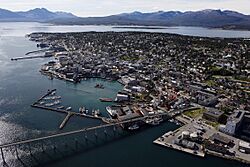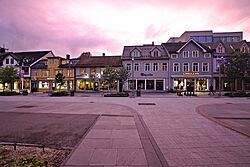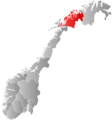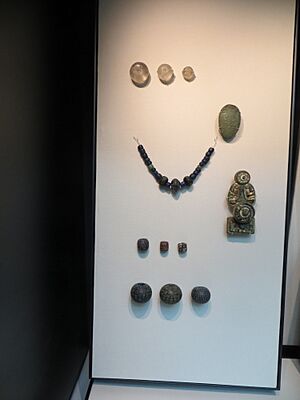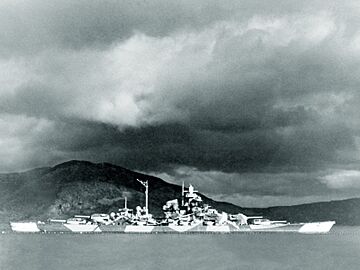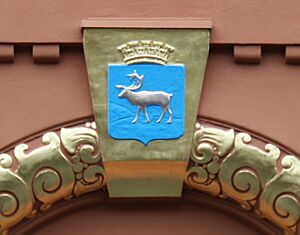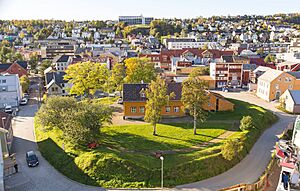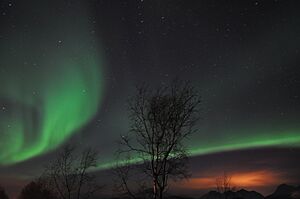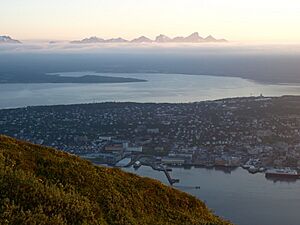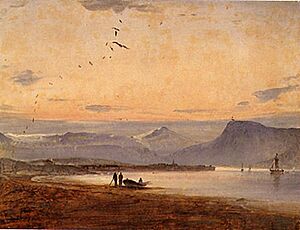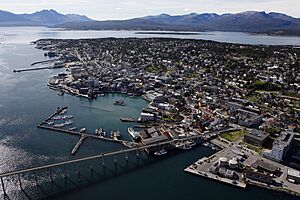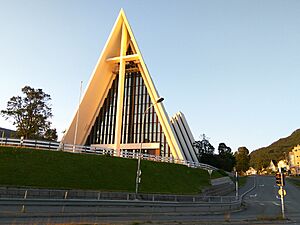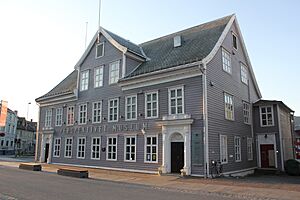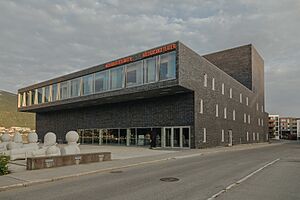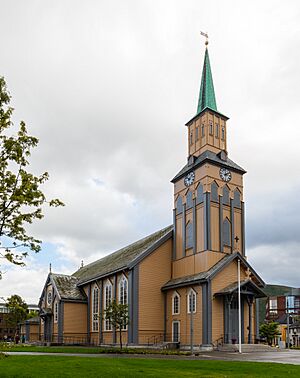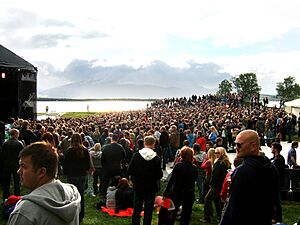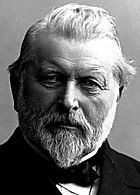Tromsø facts for kids
Quick facts for kids
Tromsø kommune
Romssa suohkan
|
|||||
|---|---|---|---|---|---|
|
Municipality
|
|||||
|
|||||
| Nickname(s):
Nordens Paris (Paris of the North), Ishavsbyen, 9000-byen, Beste byen
|
|||||
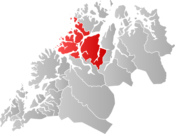
Tromsø within Troms
|
|||||
| Country | Norway | ||||
| County | Troms | ||||
| District | Hålogaland | ||||
| Established | 1 January 1838 | ||||
| Administrative centre | Tromsø | ||||
| Area | |||||
| • Total | 2,520.80 km2 (973.29 sq mi) | ||||
| • Land | 2,472.43 km2 (954.61 sq mi) | ||||
| • Water | 48.37 km2 (18.68 sq mi) 1.9% | ||||
| Area rank | #21 in Norway | ||||
| Population
(2024)
|
|||||
| • Total | 78,745 | ||||
| • Rank | #12 in Norway | ||||
| • Density | 31.2/km2 (81/sq mi) | ||||
| • Change (10 years) | 10% | ||||
| Demonym(s) | Tromsøværing | ||||
| Time zone | UTC+01:00 (CET) | ||||
| • Summer (DST) | UTC+02:00 (CEST) | ||||
| ISO 3166 code | NO-5501 | ||||
| Official language form | Neutral | ||||
| Created as | Formannskapsdistrikt in 1838 | ||||
|
|
|||||
Tromsø is a large municipality in Troms county, Norway. It is often called the "Paris of the North". The main city of Tromsø is the administrative center for the whole municipality. Other important villages include Sommarøy and Tromsdalen.
Tromsø is located in Northern Norway. It is the 21st largest municipality in Norway by area. With about 78,745 people, it is the 12th most populated municipality in the country. Tromsø is the biggest urban area in Northern Norway. It is also the third largest city north of the Arctic Circle worldwide. The city center is on Tromsøya island. However, the urban area also covers parts of the mainland and Kvaløya island. Tromsø is about 350 kilometers (217 miles) north of the Arctic Circle. Bridges and tunnels connect the islands to the mainland.
The climate in Tromsø is milder than other places at the same latitude. This is because of warm ocean currents from the Gulf Stream. Due to its far northern location, Tromsø experiences the midnight sun in summer. It also has polar night in winter.
The city center has many old wooden houses. The oldest one dates back to 1789. Tromsø is a lively cultural center for the region. Many festivals happen here, especially in summer.
Contents
- Understanding the Name of Tromsø
- A Look at Tromsø's Past
- Tromsø's Coat of Arms
- Exploring Tromsø's Geography
- Climate Change and Tromsø
- The Cityscape of Tromsø
- Tromsø's Economy
- People of Tromsø
- Culture in Tromsø
- Festivals and Fun Events
- Sports in Tromsø
- Famous People from Tromsø
- Twin Towns and Sister Cities
- Images for kids
Understanding the Name of Tromsø
The city of Tromsø gets its name from the island it sits on, called Tromsøya. The "øy" part of the name means "island." But where "Troms-" comes from is a bit of a mystery.
Different Ideas About the Name
One idea is that "Troms-" comes from an old name for the island, Trums. Many islands and rivers in Norway are called Tromsa. These names might come from a word meaning "strong current."
Another idea is that Tromsøya was first called "Little Tromsøya." This is because it is close to a much bigger island, Kvaløya. This bigger island might have been called "Big Tromsøya." This is due to a special mountain there called Tromma, which means "the Drum." The Sámi name for this mountain, Rumbbučohkka, means the same thing. It was said to be a sacred mountain for the Sámi people long ago.
Sámi Name for Tromsø
The Sámi name for the island is Romsa. People think this name came from the Norse language. However, in the Sámi language, the "t" sound at the beginning often disappears. There is also an informal Sámi name, Tromsa. Some people think the Norwegian name of Tromsø came from the Sámi name. But this idea does not explain what Romsa means.
A common mistake is to think the Sámi name is Romssa with a double "s." This form is used when talking about "Tromsø Municipality" (Romssa suohkan). In Finnish, the word is written with a double "s": Tromssa.
A Look at Tromsø's Past
People have lived in the Tromsø area since the last ice age ended. Old tools and building remains found in Tønsvika are about 9,000 to 10,000 years old.
Tromsø in the Middle Ages
The history of Norse and Sámi people in this area is very clear. A Norse chieftain named Ohthere lived here around the year 890. He said he lived "furthest to the North of all Norwegians." He mentioned that areas north of him were home to the Sámi.
An old Icelandic book from the 12th century also says that the Malangen fjord was a border. It separated Norse and Sámi coastal settlements during the Middle Ages. But old finds show that Vikings were on the main island too. A sword and other fighting tools were found near today's airport. Also, one of Northern Norway's biggest Viking treasures was found on the island. Sámi people also lived along the coast south of this border. Some Norse settlements were found north of Malangen.
The first church on Tromsøya island was built in 1252. It was called "The Church of Saint Mary in Troms near the Heathens." The "heathens" referred to the Sámi people. At that time, it was the northernmost church in the world. Around the same time, a dirt wall was built to protect the area. This wall helped against attacks from Karelia and Russia.
Tromsø was not just a Norwegian outpost. It was also a border town with Russia. The Novgorod state could tax the Sámi along the coast. Norway could tax areas further east. Over the next 500 years, Norway's border moved east. This made Tromsø less of a "frontier town."
1700s and 1800s: The "Paris of the North"
In the 1600s, Denmark–Norway wanted to control the northern coast of Scandinavia. So, they built a fort called Skansen. Even though only about 80 people lived there, Tromsø became a city on June 20, 1794. This happened because the city of Bergen lost its special right to trade cod. Tromsø quickly became more important.
The Diocese of Hålogaland was created in 1804. Tromsø became its own municipality on January 1, 1838.
Hunting in the Arctic, from Novaya Zemlya to Canada, began around 1820. By 1850, Tromsø was the main center for Arctic hunting. It took over from Hammerfest. Tromsø traded with Central Europe and Russia. This led to a special language called Russenorsk, which was a mix of Russian and Norwegian.
In 1848, a teacher training college moved to Tromsø. It helped educate Sámi students. The Tromsø Museum opened in 1872, and the Mack Brewery in 1877.
During the 1800s, Tromsø became known as the "Paris of the North." No one is quite sure why. But it is thought that people in Tromsø seemed much more stylish than visitors expected.
Early 1900s: Exploring and War Times
By the end of the 1800s, Tromsø was a big Arctic trading hub. Many Arctic expeditions started from here. Famous explorers like Roald Amundsen, Umberto Nobile, and Fridtjof Nansen used the knowledge of Tromsø. They often hired their crews in the city. The Northern Lights observatory was built in 1927.
When Germany invaded Norway in 1940, Tromsø was briefly the seat of the Norwegian government. General Carl Gustav Fleischer arrived in Tromsø on April 10, 1940. He ordered everyone to prepare for war. He declared Northern Norway a war zone. The Germans eventually took over all of Norway.
Tromsø itself was not damaged during the war. However, the German battleship Tirpitz was sunk near Tromsø island on November 12, 1944. Almost 1,000 German sailors died.
After the war, thousands of refugees came to Tromsø. They were from Finnmark county and northern Troms. These areas were destroyed by German forces.
Late 1900s to Today: Fast Growth
Tromsø grew very quickly after World War II. On January 1, 1964, several nearby municipalities joined Tromsø. This almost tripled Tromsø's population. It went from 12,430 to 32,664 people. The population has continued to grow strongly. Sometimes, more than 1,000 new residents move to Tromsø each year.
A big change was the opening of Tromsø Airport in 1964. In 1972, the University of Tromsø opened. It was one of only four universities in Norway at the time. It was the only one serving the northern part of the country. The Norwegian Polar Institute moved to Tromsø from Oslo in 1998. The university has grown even more by joining with other colleges.
How Tromsø Municipality Grew
The city of Tromsø became its own municipality on January 1, 1838. It was surrounded by the rural municipality of Tromsø. But they were governed separately. As the city got bigger, parts of the rural area were added to the city.
In 1861, an area with 110 people joined the city. In 1873, an empty area was added. In 1915, another area with 512 people merged into the city. In 1955, the Bjerkaker area on Tromsøya (with 1,583 people) also joined the city.
In the 1960s, many municipalities in Norway merged. On January 1, 1964, the city of Tromsø (12,602 people) merged with:
- Tromsøysund Municipality (16,727 people)
- Most of Ullsfjord Municipality (2,019 people)
- Most of Hillesøy Municipality (1,316 people)
This created the much larger Tromsø Municipality we know today.
On January 1, 2020, Tromsø became part of the new Troms og Finnmark county. This county replaced the old Troms county. But on January 1, 2024, Troms og Finnmark county was split. Tromsø is now back in Troms county.
Tromsø's Coat of Arms
The current coat of arms for Tromsø was approved on July 22, 1983. But a similar design has been used since 1870. The official description says it is a silver reindeer walking on a blue background.
The reindeer is usually white. If it is made of metal, it is silver. It often has a crown with five or four towers on top. The city uses a special drawing of the coat of arms made by Hallvard Trætteberg. This design was approved in 1941.
The idea for a coat of arms for Tromsø came about in 1855. It was first used at an exhibition in Tromsø in 1870. Over time, the background color has changed between blue and red. At one point, it even had a natural landscape in the background. Even though reindeer did not play a big role in the city itself, Tromsø was the main center for the large areas around it. In these areas, reindeer herding was very common.
Exploring Tromsø's Geography
Tromsø is the 12th largest municipality in Norway. It has a population of 78,745 people. The city is home to the world's northernmost university. It also has the northernmost botanical garden and planetarium.
City Layout and Surroundings
The city center is on the east side of Tromsøya island. It is over 300 kilometers (186 miles) north of the Arctic Circle. Areas outside the city center include Kroken and Tromsdalen on the mainland. The rest of Tromsøya island and the eastern part of Kvaløya are also part of the urban area.
The Tromsø Bridge and Tromsøysund Tunnel connect the mainland to Tromsøya by road. On the west side of the city, the Sandnessund Bridge connects Tromsøya island to Kvaløya island.
Mountains and Islands
The highest point in the municipality is Jiehkkevárri mountain, which is 1,830.7 meters (6,006 feet) tall. Many other tall mountains are also in the municipality. These include Hamperokken, Store Blåmannen, Store Fornestinden, and Tromsdalstinden. The Lyngen Alps mountain range is along the border between Tromsø and Lyngen municipalities.
Tromsø municipality has many islands. Some of these are Hillesøya, Kvaløya, Rebbenesøya, Ringvassøya, Store Sommarøya, and Tromsøya. Several fjords are also located in Tromsø. These include the Balsfjorden, Kaldfjorden, Malangen, and Ullsfjorden.
Tromsø's Climate
Tromsø has a boreal climate, which means cold winters and short summers. However, its winters are quite mild for how far north it is. This is because of the ice-free Norwegian Sea and warm air from the west.
Summers are usually cool, sometimes cloudy and rainy, and sometimes sunny. The weather can change a lot from year to year. For example, July 1980 had 430 hours of sunshine, a national record. But July 1989 only had 91 hours. The highest temperature ever recorded was 30.2 °C (86.4 °F) in July 1972.
Tromsø is known for getting a lot of snow in winter. But the streets often get icy, especially early in winter. Snowfall can vary a lot between winters. Sometimes, it gets warm enough to rain in the middle of winter. This melts the snow, which can then freeze into dangerous ice. People in Tromsø often wear spikes on their shoes, and most cars use studded tires. The most snow ever recorded was 240 centimeters (94 inches) on April 29, 1997.
The lowest temperature ever recorded was -18.4 °C (-1.1 °F) in February 1966. This is very mild for a place so far north. The average date for the last freeze in spring is May 17. The first freeze in autumn is usually October 3. This gives Tromsø a frost-free season of 138 days.
Light and Darkness in Tromsø
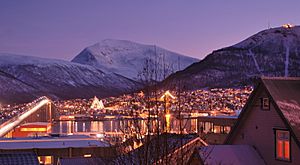
The midnight sun shines from about May 18 to July 26. But because of the mountains, you can see it from about May 21 to July 21. Since Tromsø is so far north, twilight lasts a long time. This means there is no true night between March 27 and September 17.
The sun stays below the horizon during the polar night from about November 26 to January 15. But because of the mountains, the sun is not visible from November 21 to January 21. The return of the sun is a big celebration. Even during midwinter, there are a few hours of daylight. This light is often bluish, allowing for normal day and night cycles in winter. The nights get shorter very quickly. By February 21, the sun is up from 7:45 am to 4:10 pm. By April 1, it is up from 5:50 am to 7:50 pm.
When there is snow and sunshine, from late February until the snow melts (usually late April), the light can be very bright. Sunglasses are a must when skiing. Because of these very different light conditions, Norwegians often divide winter into two seasons: Mørketid (polar night) and Seinvinter (late winter).
You can see the aurora borealis (northern lights) from Tromsø. Northern Norway is in the aurora zone. But since it's always light in summer, you cannot see the aurora between late April and mid-August. Also, because Tromsø is on the coast, it is often cloudy. This can hide the aurora, even when it is there.
Tromsø's Villages
The Tromsø municipality includes these villages:
| On Kvaløya | On Tromsøya (Tromsø (city)) |
On the Mainland |
|---|---|---|
|
|
|
Climate Change and Tromsø
In recent years, Tromsø has been getting more rain during winter. The winter season has become shorter by 17 days. Even Oslo, Norway's capital, has colder winters than Tromsø now. This is happening because of climate change. Snow often melts in the middle of winter. It is expected that Tromsø's climate will change to a humid continental climate by the year 2100.
The Cityscape of Tromsø
The city center is compact. It has the most historic wooden houses north of Trondheim. These old houses stand alongside modern buildings. The wooden houses were built between 1789 and 1904. After 1904, building wooden houses in the city center was not allowed. The oldest house in Tromsø is Skansen, built in 1789. It stands on the remains of a 13th-century dirt wall.
The Polar Museum, Polarmuseet, is in a wharf house from 1837. It shows Tromsø's history as a center for Arctic hunting. It also highlights its role as a starting point for Arctic expeditions. Tromsø Cathedral, built in 1861, is Norway's only wooden cathedral. It is in the middle of the city. The small Catholic church Vår Frue ("Our Lady") is also there.
Northern Europe's oldest cinema still in use is Verdensteatret. It was built in 1915–16. The cinema has large wall paintings by local artist Sverre Mack from 1921. These paintings show scenes from Norwegian folk tales.
The Arctic Cathedral is a modern church built in 1965. It is on the mainland, facing the city center. This church, designed by Jan Inge Hovig, is actually a parish church, not a cathedral. The Polaria aquarium and experience center opened in 1998. It is a short walk south from the city center.
The Tromsø Museum is a university museum. It shows the culture and nature of North Norway. The museum also has the Arctic-alpine botanic garden. This is the world's northernmost botanical garden. A cable car goes up to Mount Storsteinen, 420 meters (1,378 feet) above sea level. From there, you get a great view of Tromsø. The mountain Tromsdalstinden, 1,238 meters (4,062 feet) tall, is on the mainland. It is a major landmark easily seen from the city center. At the top of Tromsøya is a lake called Prestvannet.
Churches in Tromsø
The Church of Norway has eight parishes in Tromsø Municipality. These are part of the Tromsø domprosti (arch-deanery) in the Diocese of Nord-Hålogaland.
| Parish (sokn) | Church name | Location of the church | Year built |
|---|---|---|---|
| Tromsø Domkirken | Tromsø Cathedral | Tromsø | 1861 |
| Elverhøy | Elverhøy Church | Tromsø | 1803 |
| Grønnåsen | Grønnåsen Church | Tromsø | 1996 |
| Hillesøy | Hillesøy Church | Brensholmen, Kvaløya |
1889 |
| Kroken | Kroken Church | Kroken | 2006 |
| Kvaløy | Kvaløy Church | Kaldfjord | 1962 |
| Tromsøysund | Arctic Cathedral | Tromsdalen | 1965 |
| Ullsfjord | Lakselvbukt Church | Lakselvbukt | 1983 |
| Ullsfjord Church | Sjursnes | 1862 | |
| Jøvik Chapel | Jøvika | 1920 |
Tromsø's Economy

Tromsø is one of Norway's biggest fishing ports. Besides fishing, the University of Tromsø is a key place for Arctic research. Tourism has also grown a lot in recent years.
In 2021, the US Navy opened facilities at the port to service American submarines. This happened after a big expansion in 2020.
People of Tromsø
| Historical population | |||||||||||||||||||
|---|---|---|---|---|---|---|---|---|---|---|---|---|---|---|---|---|---|---|---|
| Year | 1845 | 1855 | 1865 | 1875 | 1891 | 1900 | 1910 | 1920 | 1930 | 1946 | 1951 | 1960 | 1970 | 1980 | 1990 | 2000 | 2010 | 2020 | 2024 |
| Pop. | 2,011 | 2,958 | 4,073 | 5,443 | 6,000 | 6,996 | 7,633 | 10,071 | 10,336 | 10,990 | 10,940 | 12,283 | 38,094 | 45,833 | 50,548 | 59,145 | 67,305 | 76,974 | 78,745 |
| ±% p.a. | — | +3.93% | +3.25% | +2.94% | +0.61% | +1.72% | +0.88% | +2.81% | +0.26% | +0.38% | −0.09% | +1.29% | +11.98% | +1.87% | +0.98% | +1.58% | +1.30% | +1.35% | +0.57% |
| Note: The municipal borders were changed in 1964, causing a significant change in the population. Source: Statistics Norway and Norwegian Historical Data Centre |
|||||||||||||||||||
More than 100 different nationalities live in Tromsø. Some of the larger groups include the Sami, Russians, and Finns. This includes local Kvens, who are descendants of Finnish immigrants from the 1800s. It also includes more recent immigrants from Finland.
The world's northernmost mosque is in Tromsø. The Catholic church, Our Lady, is home to the world's northernmost Catholic Bishop. This bishop leads the Roman Catholic Territorial Prelature of Tromsø. Even though the local Catholic population is small (about 350 people), Pope John Paul II visited this church in 1989.
| Main immigrant groups, 2023 | |
| Nationality | Population |
|---|---|
| 1,076 | |
| 606 | |
| 533 | |
| 524 | |
| 476 | |
| 399 | |
| 389 | |
| 353 | |
| 340 | |
| 330 | |
| 303 | |
| 256 | |
| 224 | |
| 202 | |
| 194 | |
Sami Culture in Tromsø
As mentioned in its history, the Tromsø area has a long Sámi heritage. However, the local Sámi culture became less visible in the 1900s. This was due to the assimilation of the Coastal Sámi.
Today, Tromsø has a Sámi kindergarten. Some schools offer Sámi language classes. Efforts have been made to help the Sámi language grow. A Sami language center was set up in Lakselvbukt. Tromsø Municipality generally supports the local Sámi culture. For example, the municipality celebrates Sámi People's Day. Signs at the university are in both Norwegian and Sámi. When the city tried to host the Winter Olympics, the Sámi name for Tromsø, Romsa, was part of the proposed logo.
Culture in Tromsø
As the largest city in Northern Norway, Tromsø is a cultural hub. It gained international attention on June 11, 2005. On that day, it hosted one of six 46664 concerts. These concerts aimed to raise awareness about HIV/AIDS. Torbjørn Brundtland and Svein Berge from the music duo Röyksopp grew up in Tromsø. So did singer Lene Marlin.
Many cultural events happen at the Cultural Centre (Norwegian: Kulturhuset). These include concerts by the Norwegian Arctic Philharmonic Orchestra. Tromsø also has a professional theatre group. They perform at the new Hålogaland Teater, which opened in 2005.
The city has several museums:
- The Northern Norwegian Art Gallery (Norwegian: Nordnorsk Kunstmuseum)
- The Tromsø Gallery of Contemporary Art (Norwegian: Tromsø Kunstforening)
- Norway's first and only Troll museum
- The Perspektivet Museum, which focuses on writer Cora Sandel and documentary photography.
The Tromsø techno scene is where many important Norwegian electronic music artists started. Tromsø was a leading city for house and techno music in Norway in the late 1980s. Röyksopp and the ambient electronic musician Geir Jenssen (known as Biosphere) are both from Tromsø.
The local newspapers are iTromsø and Nordlys.
The Arctic Council has its main office in Tromsø.
Festivals and Fun Events
The Tromsø International Film Festival and Nordlysfestivalen (the Aurora Borealis Festival) happen in January. The Aurora Borealis Festival is a classical music festival. The end of January is marked by the 'Day of the Sun' (Soldagen). This is when the sun finally appears after the Polar Night. Children especially celebrate this day.
The International Day of the Sami People is celebrated at the University of Tromsø and the city hall every year on February 6. Tromsø's Latin American Festival, No Siesta Fiesta, is held in late February. It started in 2007. It shows "the best of Latin America" in Northern Norway. It includes films, dance, music, art, talks, markets, and a street Samba parade. Every autumn, the Insomnia Festival for electronic music is held. It is one of the biggest and most important electronic music festivals in Norway.
The Bukta Tromsø Open Air Festival is a popular music festival. It is held in June and July. The Bukta festival is mainly a rock festival. But it also features other modern music styles. The festival takes place in Telegrafbukta, a park on Tromsøya island. Other popular summer events for people in Tromsø are the Karlsøy festival and the Riddu Riddu festival. Both are held in the region around the city.
Sports in Tromsø
Tromsø is home to many football clubs. The three most well-known are:
- Tromsø IL: Plays in the Norwegian Premier League. It is the world's northernmost Premier League football team.
- I.F. Fløya: Plays in the Norwegian First Division (women).
- Tromsdalen U.I.L.: Plays in the Adeccoliga.
The Tromsø Midnight Sun Marathon happens every June. A Polar Night Halfmarathon also takes place in January. The city has many top-division sports clubs. These include:
- Tromsø Storm in the BLNO (basketball)
- BK Tromsø in the top volleyball league for men
- Tromsø Volley in the top volleyball league for women
The oldest sports club in Tromsø is Tromsø Turnforening. This gymnastics club was founded in 1862. It also helped start the football club Tromsø IL.
Tromsø was chosen as Norway's candidate for the 2018 Winter Olympics. If it had been chosen, Tromsø would have been the first city north of the Arctic Circle to host the games. There were plans to use ships as the media village. But in October 2008, the Norwegian Olympic Committee stopped Tromsø's bid. They said the costs were too high.
There is a lit cross-country ski track on Tromsøya island. A ski jump is also on the island, near the university. In spring 2010, the city's first ice hockey arena opened. It is home to Tromsø Hockey. Tromsø also has the northernmost tennis club in Norway.
Famous People from Tromsø
Public Figures
- Johannes Steen (1827–1906): Teacher, politician, and Prime Minister of Norway from 1891-1893. He was also Mayor of Tromsø.
- Oscar Nissen (1843–1911): Doctor, newspaper editor, and politician.
- Paul Steenstrup Koht (1844–1892): Teacher, politician, city mayor, and member of the Storting (Norwegian Parliament).
- Hans Jacob Horst (1848–1931): Politician and member of the International Court of Arbitration.
- Just Knud Qvigstad (1853–1957): Expert in languages, history, and culture. He was also a headmaster and Mayor of Tromsø.
- Dorothea Schjoldager (1853–1938): A strong supporter of women's rights, a teacher, and social worker.
- James Trane (1857–1936): Norwegian-American inventor who helped start the company Trane.
- Einar Hoidale (1870–1952): Lawyer, newspaper editor, and politician from Minnesota, USA.
- Arnold Holmboe (1873–1956): Politician for the Liberal Party and Mayor of Tromsø.
- Halvdan Koht (1873–1965): Historian, politician, and former head of the Ministry of Foreign Affairs.
- Kirsten Sand (1895–1996): The first fully qualified female Norwegian architect.
- Einar Johansen (1915–1996): Engineer and a decorated member of the Norwegian resistance movement during WWII.
- Martin Siem (1915–1996): Businessperson and WWII resistance member.
- Daniel Carleton Gajdusek (1923–2008): American doctor and researcher who won the Nobel Prize in Physiology or Medicine.
- Hermod Skånland (1925–2011): Economist and Governor of the Central Bank of Norway.
- Gerd Fleischer (born 1942): Human rights activist.
- Mads Gilbert (born 1947): Doctor, humanitarian, activist, and politician.
- Herman Kristoffersen (born 1947): Former long-serving Mayor of Tromsø, known as Red Hermann.
- Hans-Tore Bjerkaas (born 1951): Former Director-General of the Norwegian Broadcasting Corporation.
Artists and Performers
- Jorgen Dreyer (1877–1948): American sculptor who moved from Norway in 1903.
- Cora Sandel (1880–1974): Writer and painter.
- Peter Wessel Zapffe (1899–1990): Philosopher, author, lawyer, and mountaineer.
- Lars Berg (1901–1969): Teacher, novelist, and playwright.
- Egil Rasmussen (1903–1964): Author, critic, and pianist who grew up in Tromsø.
- Kristian Kristiansen (1909–1980): Novelist and writer.
- Rønnaug Alten (1910–2001): Actress and stage director.
- Yngvar Ustvedt (1928–2007): Writer, biographer, and radio personality.
- Per Bronken (1935–2002): Poet, novelist, actor, and film director.
- Arthur Arntzen (born 1937): Journalist, humorist, actor, and writer.
- Kirsti Sparboe (born 1946): Singer and actress.
- Jorun Thørring (born 1955): Gynecologist and author.
- Geir Jenssen (born 1962): Electronic musician known as Biosphere.
- The Pussycats (band 1964): A pop-rock band.
- Erik Skjoldbjærg (born 1964): Writer and film director.
- Helge Andreas Norbakken (born 1965): Drummer.
- Anneli Drecker (born 1969): Singer, actress, and lead singer for Bel Canto.
- Dag-Are Haugan (born 1970): Musician with the group Alog.
- Espen Lind (born 1971): Record producer, songwriter, and singer.
- Espen Sommer Eide (born 1972): Composer and musician with Alog.
- Thomas Thormodsæter Haugen (born 1974): Musician in the black metal band Emperor.
- Lisa Stokke (born 1975): Actor and singer.
- Svein Berge (born 1976) and Torbjørn Brundtland (born 1975): Musicians in the duo Röyksopp.
- Ewa Da Cruz (born 1976): Norwegian-American television and film actress.
- Lene Marlin (born 1980): Singer-songwriter and musician.
- Dagny Norvoll Sandvik (born 1990): Singer, pop musician, and songwriter.
Sports Figures
- Per-Mathias Høgmo (born 1959): Football manager for both the men's and women's national football teams.
- Bjørn Johansen (born 1969): Former Norwegian footballer.
- Roger Nilsen (born 1969): Football coach and former player for Norway.
- Bjarte Engen Vik (born 1971): Former Norwegian Nordic combined athlete and Olympic medalist.
- Ole Martin Årst (born 1974): Retired footballer who grew up in Tromsø and played for Norway.
- Ailo Gaup (born 1979): Former Freestyle Motocross rider who invented the Underflip trick.
- Morten Giæver (born 1982): Football midfielder who grew up in Tromsø.
- Ruben Yttergård Jenssen (born 1988): Footballer who played for Norway.
- Guro Pettersen (born 1991): Football goalkeeper for the Norway national team.
- Vilde Nilsen (born 2001): Paralympic cross-country skier and biathlete.
- Elling Carlsen (1819–1900): Skipper, seal hunter, and explorer.
- Richard With (1846–1930): Ship's captain, businessman, and politician.
- Henry Rudi (1889–1970): Trapper and polar bear hunter.
Twin Towns and Sister Cities
Tromsø has special partnerships with other cities around the world. These are called "twin towns" or "sister cities."
Tromsø had a sister city agreement with Murmansk in Russia from 1972. But they ended this agreement in October 2022. This decision was made after the Russian invasion of Ukraine in February 2022.
Images for kids
-
The Coastal Seafood Center in Northern Norway (Norwegian: Kystens Hus).
 In Spanish: Tromsø para niños
In Spanish: Tromsø para niños


